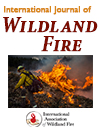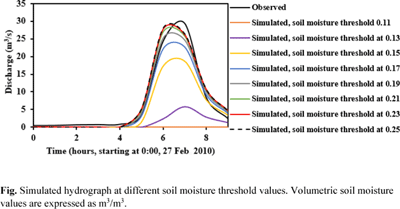International Journal of Wildland Fire
Volume 33
Number 4 2024
A spatially explicit forecast calculation system was designed and implemented to assess a new fire danger rating system for Australia based on fire behaviour models, weather inputs and a national fuel spatial data layer. This article is part of a collection about the Australian Fire Danger Rating System.
This article belongs to the Collection Australian Fire Danger Rating System.
Using Albany Pine Bush Preserve (USA) as a case study, this research reports the potentiality of an open-path Fourier transform methodology to assess the trends of volatile organic compounds emissions during prescribed fires.
Recovery of soil microbes is crucial for the entire forest ecosystem following a fire. Our research, using simulated burns, revealed that soil microbial biomass began to recover only 20 days post‐disturbance, with subsurface soil microbes playing a key role. Heat indicators were found to more significantly influence microbial responses than soil physiochemical properties.
A Research Prototype of the Australian Fire Danger Rating System (AFDRSRP) was designed and tested in a live trial. Fire danger ratings derived from the AFDRSRP and FFDI/GFDI systems were compared to expert-derived ratings for 336 fires. In this paper the results of the live trial are presented and discussed.
This article belongs to the Collection Australian Fire Danger Rating System.
Australian fire and land management agencies use fire simulators to predict characteristics of fires in the landscape, and require evaluation of simulator accuracy. Simulations of fire spread were assessed against observations. Inputs were perturbed to evaluate simulator sensitivity. Against the evaluation measures, no simulators proved universally superior to the others.
Geodiversity provides valuable benefits through its existence and function. Fire can degrade geodiversity elements in several ways, on vast spatial and temporal scales, with implications for geoconservation and protected areas management. Understanding recovery rates of geodiversity elements, and the cumulative impact of fire on geodiversity, requires further research.
This work evaluated the propensity for spotting ignition of peat soil by a single glowing firebrand. We found that a new smouldering fire on the peat layer can be easily initiated by a firebrand that may fly over a firebreak to quickly expand burning regions in peatland.
The ROS of surface fire in Pinus koraiensis plantation was measured in the laboratory for different fuel loads, fuel moisture contents, and slope conditions. Fuel particle and environmental parameters in the Rothermel model were modified. The modified IR and ϕS parameters significantly improved the Rothemel model prediction accuracy.
At a watershed scale, the impact of wildfires on runoff following a precipitation event is greatest when the soil is dry and decreases sharply as soil moisture increases. Once the post-wildfire soil moisture reaches the threshold value of 0.25 m3/m3, flooding due to water repellency is no longer significant.
A methodology offering a comprehensive interpretation of wildfire risk considering both wildfire likelihood and asset vulnerability is proposed. The former is estimated with an event tree, while the latter is considered as the ignition probability of a polymeric fuel within a critical infrastructure. Wildfire risk is ~10−4 events/year.
This article belongs to the Collection ICFFR.
Satellite products with a direct physical meaning were accurate for estimating fire behaviour (surface fire, intermittent crown fire, and continuous crown fire) of past wildfire events across large burned Mediterranean ecosystems. This has major implications for anticipating post-fire ecosystem responses (e.g. delayed tree mortality).
Knowledge about firebrand burning characteristics is essential for predicting the flight distance and trajectory for transport. This work studies the flaming and smouldering burning of firebrands under forced convection. Models are established for burning rate, projected area and surface temperature of firebrands, and applied to predict firebrand transport.
Volunteer firefighters in Western Australia have a significant knowledge gap about of bushfire smoke health risks and protection. Forestry firefighters are more informed but still face issues like inadequate respiratory protection and lack of decontamination facilities. Better education and essential resources are crucial to improving safety for all firefighters.
We created two innovative spatially explicit measures of ecological departure incorporating stochasticity of reference conditions for each ecological system and all ecological systems applied to remotely sensed vegetation layers from a central Nevada, USA, landscape. These new metrics could facilitate localised vegetation and wildlife habitat management, and land protection decisions.
Savanna fire management has proved to be an effective mechanism for reducing greenhouse gas emissions and increasing carbon storage in ecosystems. In this study, we calibrate the FullCAM carbon accounting model with extensive field data to improve the model’s representation of fire impacts and carbon dynamics in Australian savannas, and to facilitate carbon accounting at project to national scales.
This cross-sectional study investigated the age and physical activity status of Australian volunteer firefighters. The mean age was 51.4 years. We found that volunteer firefighters were more likely to meet the national physical activity and exercise-only guidelines, but less likely to meet the strength-based training guidelines compared with the general Australian population.






